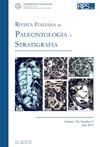THE DISTRIBUTION RANGE OF CALCAREOUS NANNOFOSSIL SPECIES RETICULOFENESTRA PSEUDOUMBILICUS IN THE MIOCENE: AN EXAMPLE OF ECOLOGICAL INFLUENCE ON EVOLUTIONARY DEVELOPMENT
IF 1.9
3区 地球科学
Q2 GEOLOGY
引用次数: 0
Abstract
Reticulofenestra pseudoumbilicus is a Neogene calcareous nannofossil species whose highest stratigraphic occurrence (Top) is a reliable biohorizon in the Pliocene, calibrated at 3.82 Ma. The species is present in the stratigraphic record from at least the Middle Miocene, within an interval around the biohorizon Top Sphenolithus heteromorphus, calibrated at 13.53 Ma, but its lower distribution range is not precisely delineated. The study of nannofossil assemblages in sediment cores from Integrated Ocean Drilling Program IODP Site U1338 (eastern equatorial Pacific) indicates a lower stratigraphic position for the evolutionary emergence (Base) of R. pseudoumbilicus, detected in the Early Miocene with an estimated age of 16.46 Ma. This age results from a new astronomically tuned chronology, which dates the deepest sediments at Site U1338 to 16.67 Ma. Base R. pseudoumbilicus is followed above by a temporary disappearance of the taxon until a re-entrance after ~3 Myr. This lengthened stratigraphic range has been confirmed by data from other locations at low and mid-latitudes in the Atlantic. The distribution range of R. pseudoumbilicus, lasting ~13 Myr during the Neogene, is thus characterized by a variable pattern of repeated occurrences and disappearances. Comparison to benthic foraminifera δ18O and δ13C records suggests a control by global climatic/environmental conditions on these events, particularly by temperature variations. The recurrent presence of R. pseudoumbilicus at stratigraphically different intervals could represent an example of iterative evolution, expressed as repeated speciation events that are in part influenced by complex external factors related to the dynamic climate and environmental evolution during the Miocene.中新世钙质纳米化石的分布范围:生态对进化发展的影响
Reticulofenestra pseudoumbilicus是一种新近系钙质纳米化石,其最高地层产状(Top)是上新世的可靠生物层位,校准为3.82 Ma。该物种存在于至少中新世中期的地层记录中,在生物层位Top Sphenolithus heteromorphus周围的间隔内,校准为13.53 Ma,但其较低的分布范围并未精确划定。综合海洋钻探计划(IODP) U1338地点(东赤道太平洋)沉积物岩心的纳米化石组合研究表明,在中新世早期发现的r.p uloumbilicus的进化出现(基地)位置较低,估计年龄为16.46 Ma。这个年龄来自一种新的天文校正年代学,它将U1338遗址最深的沉积物定年为16.67 Ma。在此之后,该分类群暂时消失,直到约3myr后重新进入。大西洋低纬度和中纬度地区其他地点的数据证实了这种延长的地层范围。因此,在新近纪期间,假瘤鼠的分布范围持续了~13 Myr,具有反复出现和消失的变化模式。与底栖有孔虫的δ18O和δ13C记录比较表明,这些事件受全球气候/环境条件的控制,特别是受温度变化的控制。在不同的地层间隔中反复出现的假圆尾鼠可能代表了一个迭代进化的例子,表现为重复的物种形成事件,这些事件在一定程度上受中新世动态气候和环境演化相关的复杂外部因素的影响。
本文章由计算机程序翻译,如有差异,请以英文原文为准。
求助全文
约1分钟内获得全文
求助全文
来源期刊
CiteScore
3.60
自引率
4.30%
发文量
28
审稿时长
>12 weeks
期刊介绍:
The Rivista Italiana di Paleontologia e Stratigrafia was founded in 1895. It publishes original papers dealing with all fields of paleontology and of stratigraphy, from Italy and the Mediterranean to the Tethys, as well across the globe from China to North America.

 求助内容:
求助内容: 应助结果提醒方式:
应助结果提醒方式:


